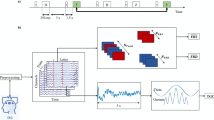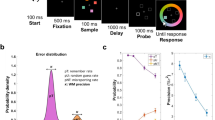Abstract
Differences of EEG synchronization between normal old and young people during a working memory (WM) task were investigated. The synchronization likelihood (SL) is a novel method to assessed synchronization in multivariate time series for non-stationary systems. To evaluate this method to study the mechanisms of WM, we calculated the SL values in brain electrical activity for both resting state and task state. EEG signals were recorded from 14 young adults and 12 old adults during two different states, respectively. SL was used to measure EEG synchronization between 19 electrodes in delta, theta, alpha1, alpha2 and beta frequency bands. Bad task performance and significantly decreased EEG synchronization were found in old group compared to young group in alpha1, alpha2 and beta frequency bands during the WM task. Moreover, significantly decreased EEG synchronization in beta band in the elder was also detected during the resting state. The findings suggested that reduced EEG synchronization may be one of causes for WM capacity decline along with healthy aging.






Similar content being viewed by others
References
Baddeley A (2003) Working memory: looking back and looking forward. Nat Rev Neurosci 4(10):829–839
Baudouin A, Vanneste S, Pouthas V et al (2006) Age-related changes in duration reproduction: involvement of working memory processes. Brain Cogn 62(1):17–23
Bernarding C, Strauss DJ, Hannemann R et al (2017) Neurodynamic evaluation of hearing aid features using EEG correlates of listening effort. Cogn Neurodyn 11(3):203–215
Betzel RF, Erickson MA, Malene A et al (2012) Synchronization dynamics and evidence for a repertoire of network states in resting EEG. Front Comput Neurosci 6:1–13
Chew LH, Teo J, Mountstephens J (2016) Aesthetic preference recognition of 3D shapes using EEG. Cogn Neurodyn 10(2):165–173
Draganski B, Lutti A, Kherif F (2013) Impact of brain aging and neurodegeneration on cognition: evidence from MRI. Curr Opin Neurol 26(6):640–645
Duru AD, Assem M (2017) Investigating neural efficiency of elite karate athletes during a mental arithmetic task using EEG. Cogn Neurodyn 12(1):95–102
Folstein MF, Folstein SE, McHugh PR (1975) “Mini-mental state”. A practical method for grading the cognitive state of patients for the clinician. J Psychiatr Res 12(3):189–198
Gevins AS, Schaffer RE (1980) A critical review of electroencephalographic (EEG) correlates of higher cortical functions. Crit Rev Bioeng 4(2):113–164
Gola M, Magnuski M, Szumska I et al (2013) EEG beta band activity is related to attention and attentional deficits in the visual performance of elderly subjects. Int J Psychophysiol 89(3):334–341
Grady CL (2008) Cognitive neuroscience of aging. Ann N Y Acad Sci 1124:127–144
Grady C (2012) The cognitive neuroscience of ageing. Nat Rev Neurosci 13(7):491–505
Hampson M, Driesen NR, Skudlarski P et al (2006) Brain connectivity related to working memory performance. J Neurosci 26(51):13338–13343
Heinzel S, Lorenz RC, Brockhaus WR et al (2014) Working memory load-dependent brain response predicts behavioral training gains in older adults. J Neurosci 34(4):1224–1233
Jefferies E (2013) The neural basis of semantic cognition: converging evidence from neuropsychology, neuroimaging and TMS. Cortex 49(3):611–625
John TN, Puthankattil SD, Menon R (2018) Analysis of long range dependence in the EEG signals of Alzheimer patients. Cogn Neurodyn 6:1–17
Klimesch W (1997) EEG-alpha rhythms and memory processes. Int J Psychophysiol 26(1–3):319–340
Klimesch W (1999) EEG alpha and theta oscillations reflect cognitive and memory performance: a review and analysis. Brain Res Rev 29(2–3):169–195
López-Otín C, Blasco MA, Partridge L et al (2013) The hallmarks of aging. Cell 153(6):1194–1217
Makovski T, Lavidor M (2014) Stimulating occipital cortex enhances visual working memory consolidation. Behav Brain Res 275:84–87
Mateos DM, Erra RG, Wennberg R et al (2017) Measures of entropy and complexity in altered states of consciousness. Cogn Neurodyn 1:1–12
Mazza V, Brignani D (2016) Electrophysiological advances on multiple object processing in aging. Front Aging Neurosci 8:1–7
Michels L, Moazami-Goudarzi M, Jeanmonod D et al (2008) EEG alpha distinguishes between cuneal and precuneal activation in working memory. Neuroimage 40(3):1296–1310
Morton NW, Polyn SM (2016) Beta-band activity represents the recent past during episodic encoding. Neuroimage 147:692–702
Mumtaz W, Vuong PL, Malik AS et al (2018) A review on EEG-based methods for screening and diagnosing alcohol use disorder. Cogn Neurodyn 12(2):141–156
Nyberg L, Lövdén M, Riklund K et al (2012) Memory aging and brain maintenance. Trends Cogn Sci 16(5):292–305
Olbrich S, Tränkner A, Chittka T et al (2014) Functional connectivity in major depression: increased phase synchronization between frontal cortical EEG-source estimates. Psychiatry Res Neuroimaging 222(1–2):91–99
Pereda E, Quiroga RQ, Bhattacharya J (2005) Nonlinear multivariate analysis of neurophysiological signals. Prog Neurobiol 77(1–2):1–37
Pijnenburg YAL, Made YV, van Walsum AMV et al (2004) EEG synchronization likelihood in mild cognitive impairment and Alzheimer’s disease during a working memory task. Clin Neurophysiol 115(6):1332–1336
Pinal D, Zurrón M, Díaz F (2015) An event related potentials study of the effects of age, load and maintenance duration on working memory recognition. PLoS ONE 10(11):e0143117
Protopapa F, Siettos CI, Myatchin I et al (2016) Children with well controlled epilepsy possess different spatio-temporal patterns of causal network connectivity during a visual working memory task. Cogn Neurodyn 10(2):1–13
Reuter-Lorenz PA (2013) Aging and cognitive neuroimaging: a fertile union. Perspect Psychol Sci 8(1):68–71
Rombouts SARB, Keunen RWM, Stam CJ (1995) Investigation of nonlinear structure in multichannel EEG. Phys Lett A 202(5–6):352–358
Rönnlund M, Sundström A, Nilsson LG (2015) Interindividual differences in general cognitive ability from age 18 to age 65 years are extremely stable and strongly associated with working memory capacity. Intelligence 53:59–64
Salat DH (2011) The declining infrastructure of the aging brain. Brain Connect 1(4):279–293
Schneider-Garces NJ, Gordon BA, Brumback-Peltz CR et al (2010) Span, Crunch, and beyond: working memory capacity and the aging brain. J Cogn Neurosci 22(4):655–669
Stam CJ (2000) Brain dynamics in theta and alpha frequency bands and working memory performance in humans. Neurosci Lett 286(2):115–118
Stam CJ, van Dijk BW (2002) Synchronization likelihood: an unbiased measure of generalized synchronization in multivariate data sets. Phys D Nonlinear Phenomena 163(3–4):236–251
Stam CJ, Made YV, Pijnenburg YAL et al (2003) EEG synchronization in mild cognitive impairment and Alzheimer’s disease. Acta Neurol Scand 108(2):90–96
Vinck M, Oostenveld R, Van WM et al (2011) An improved index of phase-synchronization for electrophysiological data in the presence of volume-conduction, noise and sample-size bias. Neuroimage 55(4):1548–1565
Vysata O, Kukal J, Prochazka A et al (2014) Age-related changes in EEG coherence. Neurol Neurochir Pol 48(1):35–38
Ward LM (2003) Synchronous neural oscillations and cognitive processes. Trends Cogn Sci 7(12):553–559
Wilson TW, Heinrichs-Graham E, Proskovec AL et al (2016) Neuroimaging with magnetoencephalography: a dynamic view of brain pathophysiology. Transl Res 175:17–36
Zaveri HP, Williams WJ, Sackellares JC et al (1999) Measuring the coherence of intracranial electroencephalograms. Clin Neurophysiol 110(10):1717–1725
Acknowledgements
This study was funded by the National Key Research and Development Program of China (No. 2017YFB1300303), the National Natural Science Foundation of China (Grant No. 31271061), and the Natural Science Basic Research Plan in Shaanxi Province of China (Program No. 2015JM6289).
Author information
Authors and Affiliations
Corresponding author
Rights and permissions
About this article
Cite this article
Teng, C., Cheng, Y., Wang, C. et al. Aging-related changes of EEG synchronization during a visual working memory task. Cogn Neurodyn 12, 561–568 (2018). https://doi.org/10.1007/s11571-018-9500-6
Received:
Revised:
Accepted:
Published:
Issue Date:
DOI: https://doi.org/10.1007/s11571-018-9500-6




